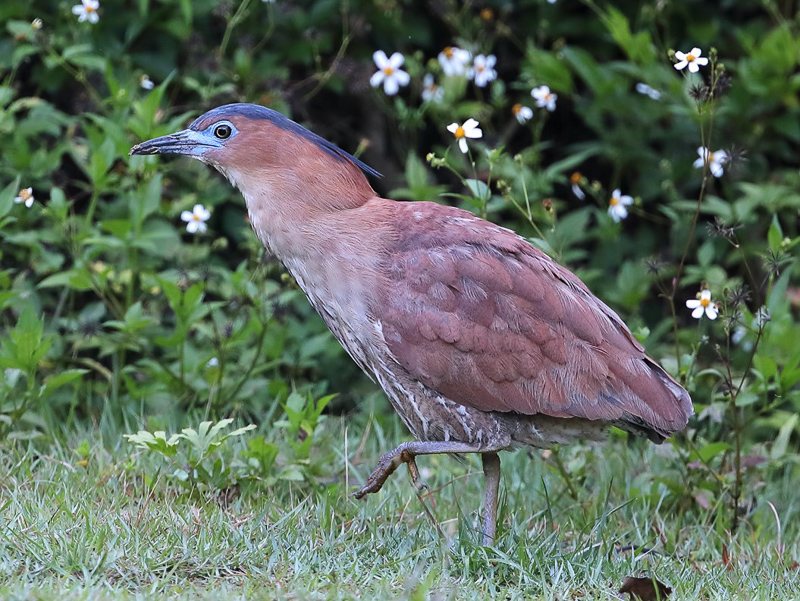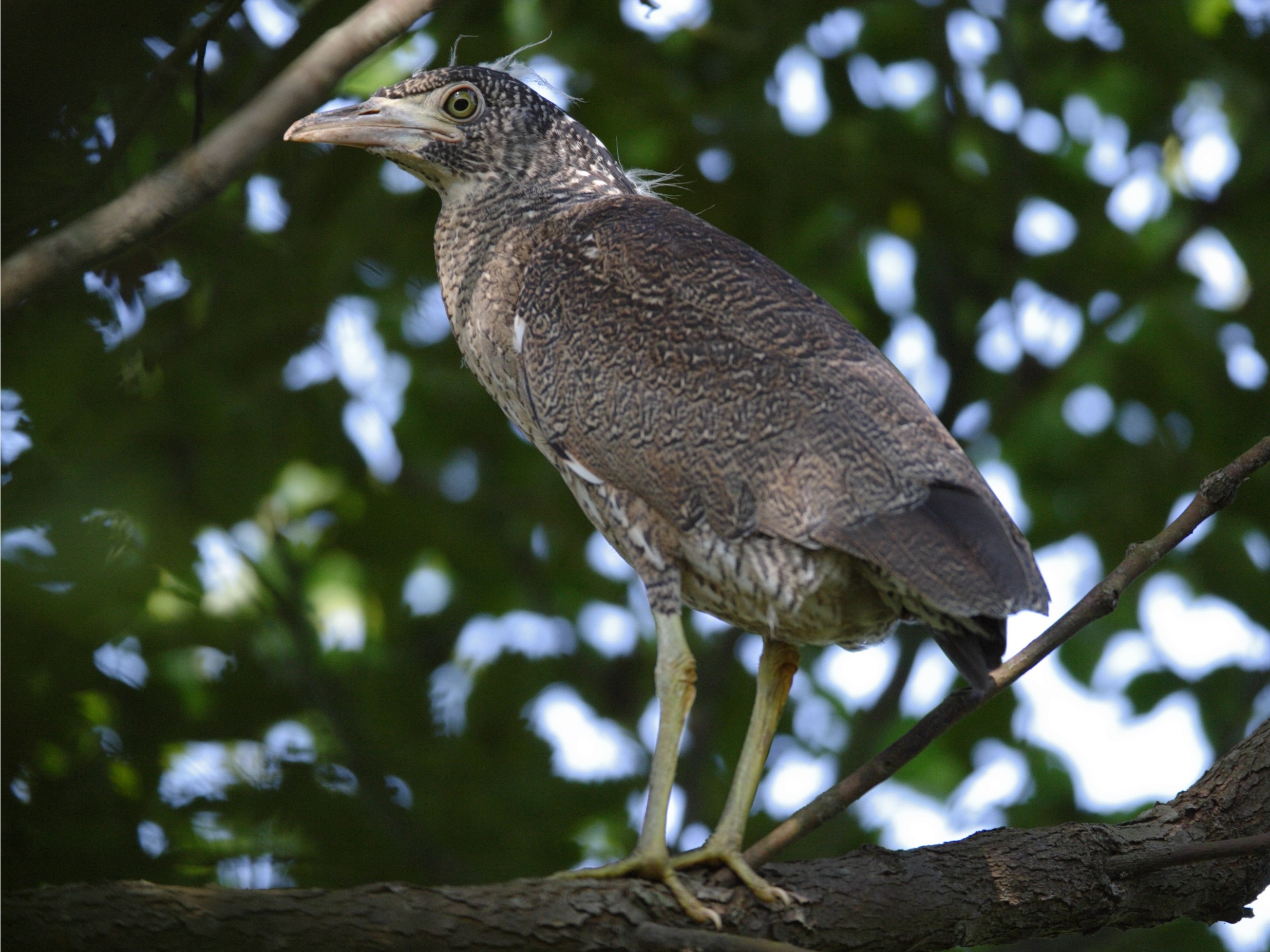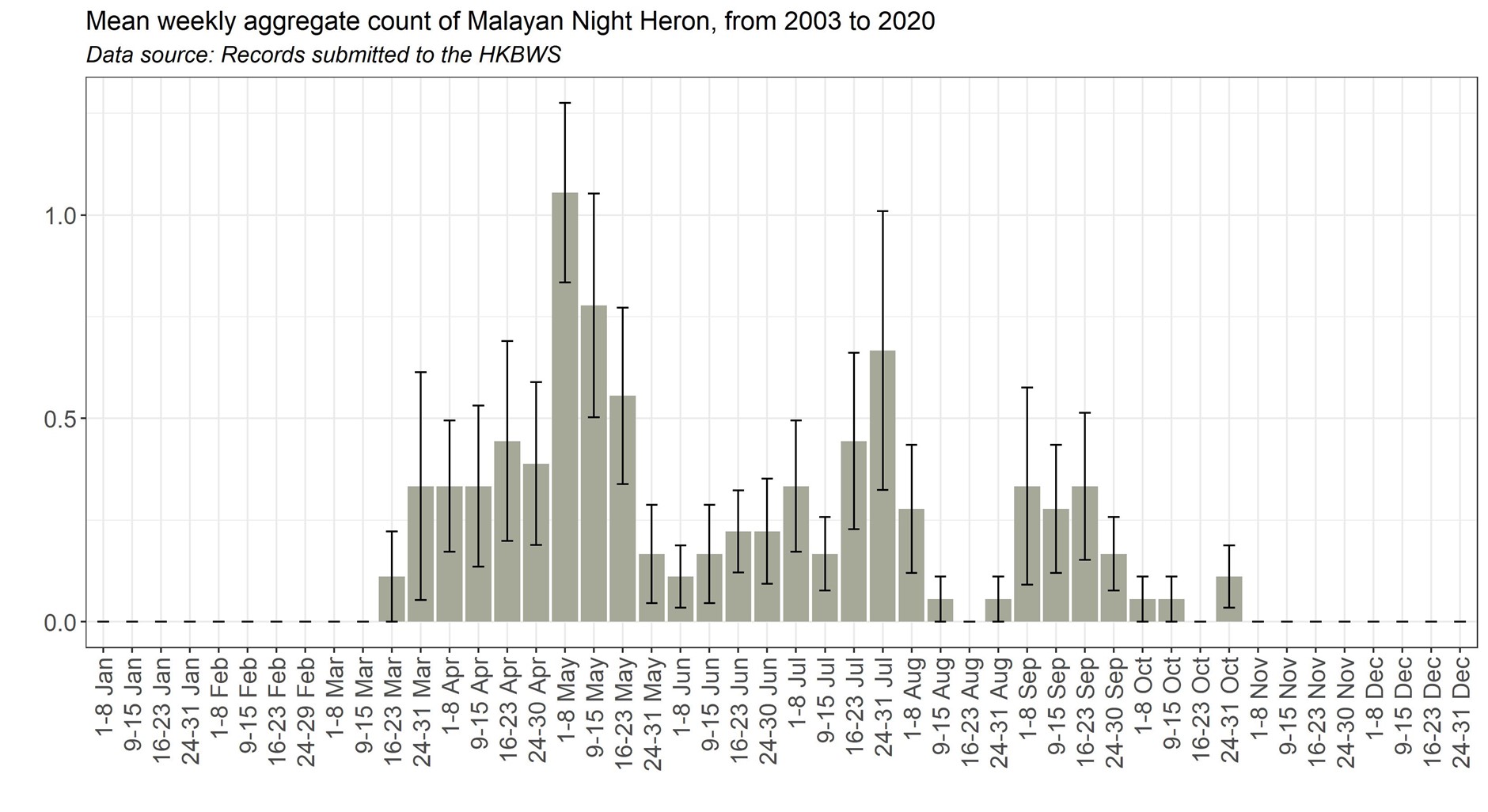Malayan Night Heron Gorsachius melanolophus 黑冠鳽
Category I. Scarce but increasing summer visitor to wooded areas, first recorded breeding in 2003. Passage migrants also occur.
IDENTIFICATION

Apr. 2020, Michelle and Peter Wong.
48-51 cm. Adults have a dark grey crown and crest that contrast with the pale chestnut sides of the head and white (not chestnut-brown) tips to the primaries. Rest of upperparts and wing coverts pale chestnut. Facial deep sky blue.

Sep. 2004, John and Jemi Holmes.
Juveniles are heavily spotted and barred and develop pale blue facial skin and dull grey legs as they progress towards adult plumage.
VOCALISATIONS
The territorial call, which is mostly heard from March to May with a few further reports in June-July and the latest on 8 August, is a deep ‘oop’ lasting about half a second and delivered singly or in a series of usually 6-10 notes, occasionally 50 or more, delivered at an even tempo at a rate of about one note per 1.5 second.
DISTRIBUTION & HABITAT PREFERENCE
Local but widespread in the New Territories and Lantau; also on Po Toi and occasionally on HK Island and Lamma. Breeding birds show a preference for fung shui woodland and closed-canopy shrubland at lower altitudes, especially where close to open grassy areas, active and abandoned farmland and reservoirs. Presumed migrants have been found at migration hotspots such as Po Toi, occasionally in forest and wetlands and once in an urban park.
OCCURRENCE
Malayan Night Heron has been recorded between 20 March and 27 October (Figure 1). From a low in March, numbers increase through April to reach a peak in the first half of May. A second peak occurs from mid-July to early August when family parties are reported. September and October reports likely refer to migrants.
Vocalising birds account for about 30% of reports. All records are of single birds or pairs, with family parties of up to four occasionally found from July to September. Records in September and October include a few individuals at sites where none were found earlier in the breeding season, such as a juvenile at HK Wetland Park during 19-29 September 2017, an adult at Shing Mun Valley Park on 27 October 2013 and an immature on Po Toi on 24 October 2019, all of which seem likely to have been passage migrants. Short-staying birds recorded in spring, such as single immatures on Po Toi (5-10 May 2009, 7-13 May 2010) and one at Long Valley on 20 April 2020, may also have been migrants.
The first HK record involved two adults camera-trapped at Lo Kei Wan, Lantau on 19 April 2003 (Cheung 2009). Two sites in the northwest New Territories (Ping Kong and Hang Tau) accounted for all records in 2004-2006. The number of sites then slowly increased in 2007-2009 and 2010-2012, though annual totals fell slightly. Subsequently, a substantial increase in both annual totals and the number of sites occurred in 2013-2015 and 2016-2018, followed by a sharp increase in 2019-2021, when totally 76 birds were recorded at altogether 26 sites, 19 of which were new (Table 1).
Table 1. Malayan Night Heron. Sum of weekly aggregates and number of sites with records in 3-year periods from 2004-2006 to 2019-2021
| 2004-2006 | 2007-2009 | 2010-2012 | 2013-2105 | 2016-2018 | 2019-2021 |
No. of birds | 19 | 9 | 9 | 26 | 31 | 76 |
Sites with records | 2 (2) | 2 (1) | 4 (2) | 12 (9) | 9 (6) | 26 (19) |
BREEDING
Nesting records span the period from early May to 28 July. One or two fledged juveniles accompanied by adults have been reported in the Ping Kong area and at Hang Tau, Wa Shan and Tai Tong from 14 July to 19 September.
Two nests have been found, both consisting of untidy collections of sticks. The first was placed about five metres above ground in a 10-metre-tall Camphor Cinnamomum camphora in a fung shui wood at Ping Kong and was used in successive years. It showed signs of recent use when first found in early September 2004, with two fledged juveniles seen close by, and it contained three young in early May of the following year. The second nest was placed about seven metres above the ground in the fork of a tree branch in shrubland at Fung Yuen and contained two well-grown young on 27-28 July 2020.
BEHAVIOUR, FORAGING & DIET
Secretive and mainly nocturnal. Nearly all records of vocalising adults are at dusk, in early evening, or at dawn. Unusually, one at Kat Hing Bridge in Tai Lam CP was vocalising in full daylight in early morning on 10 May 2020. The bird was standing on a rock in a streambed, and its neck and upper breast were seen to swell out and then rapidly deflate with each note (Li 2023).
Adults and juveniles are occasionally seen foraging in open areas of short grass in the daytime, including an adult swallowing a large earthworm at On Po village in September 2004 and a juvenile killing and swallowing a large toad, probably Bufo melanostictus, at Tai Tong on 13 September 2016, despite having a damaged bill.
RANGE & SYSTEMATICS
Monotypic. Breeds in disjunct areas of southwest India, on the Nicobar Islands, in northeast India, and from Burma to south China south, Indochina and the Philippines; it is partially resident with some populations wintering south to Sri Lanka, Borneo, Sumatra, Java and Bali (Martínez-Vilalta et al. 2020). In China occurs in southern provinces from Yunnan east to Guangdong, Hainan and Taiwan (Liu and Chen 2020).
CONSERVATION STATUS
IUCN: Least Concern. Population trend stable.
Figure 1.

Cheung, J. A. M. (2009). Malayan Night Heron Gorsachius melanolophus: the first record for Hong Kong. Hong Kong Bird Report 2003-04: 192-197.
Li, K. (2023). Available at: https:/youtu.be/0p7iYGtvEbU (Accessed 28 June 2023).
Liu, Y. and Chen, Y. H. (eds) (2020). The CNG Field Guide to the Birds of China (in Chinese). Hunan Science and Technology Publication House, Changsha.
Martínez-Vilalta, A., A. Motis, and G. M. Kirwan (2020). Malayan Night-Heron (Gorsachius melanolophus), version 1.0. In Birds of the World (J. del Hoyo, A. Elliott, J. Sargatal, D. A. Christie, and E. de Juana, Editors). Cornell Lab of Ornithology, Ithaca, NY, USA. https://doi.org/10.2173/bow.manher1.01

